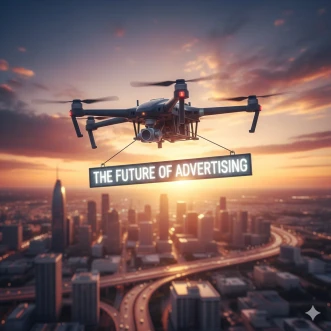Picture this: you're relaxing on a beach, enjoying a perfect summer day, when a familiar sound hums in the distance. You look up, and there it is—a Cessna 172, cruising low and slow, towing a massive banner with a message so simple it's brilliant. For decades, this has been the pinnacle of high-impact, can't-miss advertising. And let's be honest, it works. It's memorable, it's grand, and it gets the message across.
But it's also incredibly expensive. You're not just paying for the ad; you're paying for the pilot, the fuel, the aircraft maintenance, the airport fees, and the complex logistics of it all. For most businesses, it's a marketing dream that's simply out of reach. Until now.
The Drone Revolution: Taking the Plane Out of the Picture
The core concept of aerial advertising is genius: put a message in the sky where everyone can see it. The expensive part has always been the 'aerial' vehicle. What if you could achieve the same, or even better, impact without the five-figure cost of operating a full-blown airplane? That's exactly what the drone revolution has enabled.
By replacing a gas-guzzling aircraft with a highly efficient, electric drone, we can slash the operational costs of aerial advertising. This simple change democratizes the sky, making this powerful marketing tool accessible to a much wider range of businesses. But as with any new technology, not all solutions are created equal.
The Competitor's Trap: Bigger Isn't Better
As the drone advertising space has emerged, a common and, frankly, lazy approach has appeared. Many companies are simply grabbing the biggest, heaviest-lift quadcopter they can find and strapping a heavy, off-the-shelf LED sign to it. On the surface, it looks impressive. In reality, it's a brute-force method that completely misses the point.
This approach is not an engineered solution; it's just a collection of expensive, unoptimized parts. The money you pay them isn't for clever engineering—it's for a massive drone that's fighting against its own weight and the drag of a clunky sign. This leads to a cascade of problems:
- Poor Flight Times: A heavy drone carrying a heavy sign burns through batteries at an astonishing rate. You're lucky if you get more than a few minutes of flight time, which severely limits the campaign's effectiveness.
- Terrible Performance: Towing a heavy, non-aerodynamic sign is like trying to drive a sports car with a parachute attached. The drone becomes sluggish, difficult to control, and struggles against even light winds.
- Wasted Expense: You're paying a premium for a giant drone, not for a system that is actually good at its job.
Our Philosophy: An Engineered, Optimized Solution
We saw this problem from a different perspective. The goal isn't to lift the heaviest sign possible; the goal is to create the most effective, efficient, and elegant **flying billboard**. This requires a holistic approach, where the drone and the banner are designed to work together as a single, optimized system.
Our airframe isn't a generic heavy-lifter. It's an aircraft specifically designed for this mission. We've obsessed over every gram, optimizing for the perfect balance of lift, endurance, and stability. Our LED banners are custom-built to be incredibly lightweight without sacrificing brightness or clarity. This synergy between the aircraft and the payload is our secret sauce.
The result? Longer flight times, superior performance in various conditions, and a lower cost for our customers. You're not paying for a bigger drone; you're paying for a smarter solution. You're investing in the engineering that makes effective drone advertising not just possible, but practical.
The Future of Advertising is in the Sky
The era of the "drone billboard" is here, and it's evolving beyond simple, brute-force applications. The future belongs to elegant, engineered systems that are built for a purpose. By focusing on efficiency, performance, and intelligent design, we're not just making a cheaper version of airplane advertising—we're creating something fundamentally better. We're making the sky accessible, and we're doing it the right way.

Ready to turn inspiration into action? Explore our innovative drone advertising platforms. Our flying drone ads feature bright LED screens that captivate and engage audiences. From drone banners to fully custom drone billboards, unleash the potential of cutting-edge aerial marketing. Shop now to transform your advertising strategy!